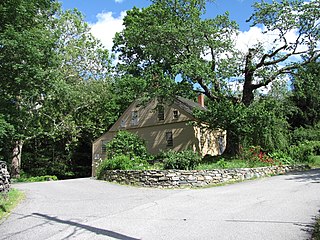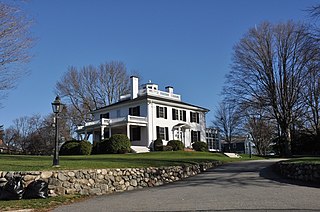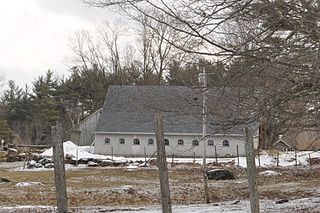
The Spencer–Peirce–Little Farm is a Colonial American farm located at 5 Little's Lane, Newbury, Massachusetts, United States, in the midst of 231 acres (93 ha) of open land bordering the Merrimack River and Plum Island Sound. The farmhouse, dating to c. 1690, was designated a National Historic Landmark in 1968 as an extremely rare 17th-century stone house in New England. It is now a nonprofit museum owned and operated by Historic New England and open to the public several days a week during the warmer months; an admission fee is charged for non Members.

The Robert Frost Farm, also known as the Homer Noble Farm, is a National Historic Landmark in Ripton, Vermont. It is a 150-acre (61 ha) farm property off Vermont Route 125 in the Green Mountains where American poet Robert Frost (1874-1963) lived and wrote in the summer and fall months from 1939 until his death in 1963. The property, historically called the Homer Noble Farm, includes a nineteenth-century farmhouse and a rustic wooden writing cabin. The property is now owned by Middlebury College. The grounds are open to the public during daylight hours.

The Cambridge Common Historic District is a historic district encompassing one of the oldest parts of Cambridge, Massachusetts. It is centered on the Cambridge Common, which was a center of civic activity in Cambridge after its founding in 1631. It was the site of the election for governor of the Massachusetts Bay Colony in 1636, and was a military barracks site during the American Revolutionary War. The common was gradually reduced in size to its present roughly triangular shape, and surrounded by buildings in the 18th and 19th centuries. In 1973 a historic district encompassing the extant common and everything within 100 feet (30 m) of it was listed on the National Register of Historic Places. In 1987 the district was amended to rationalize the boundary, which overlapped adjacent districts and included portions of some buildings.

The Willard-Fisk House is a historic farm property at 126 Whitney Street in Holden, Massachusetts. The farmhouse, built about 1772, is one of the oldest houses in Holden, and one of its oldest brick houses. The property also includes a 19th-century barn and several 20th-century farm outbuildings. The property was listed on the National Register of Historic Places in 1996, where it is listed at 121 Whitney Street.

The Freegrace Marble Farm Historic District encompasses a historic farmstead in Sutton, Massachusetts. Although most of its buildings date to the 19th century, the farm has retained the form of a typical 18th-century farm, including a substantial portion of the land granted in 1717 to Freegrace Marble, one of Sutton's earliest colonial settlers. The property was listed on the National Register of Historic Places in 1989.

Woodlawn Farm, sometimes known as the Wood Homestead, is located on Mount Orange Road, a short distance north of Slate Hill, New York, United States. It is centered by a three-section farmhouse whose materials date to the mid-18th century, making it one of the oldest buildings in the Town of Wawayanda. In 2008 it was listed on the National Register of Historic Places.

The Glen Road Historic District is a historic district at 233-317 Glen Road in Weston, Massachusetts. The district encapsulates historical development trends in Weston, in which land began in agricultural uses, and was later transformed into either resort or suburban residential housing. It is also notable for its longtime association with the Jennings family, who owned the land from the 18th century into the 20th, and engaged in all three land uses. The district was listed on the National Register of Historic Places in 2006.

Beebe Homestead, also known as the Lucius Beebe House and Beebe Farm, is a historic Federal period home at 142 Main Street in Wakefield, Massachusetts, which was built during the federal era that extended from the late 18th-century into the 1820s. It is suspected to have been remodeled into the federal style from an earlier home built in circa 1727. It overlooks Lake Quannapowitt, and according to a 1989 study of historic sites in Wakefield, the house is "one of Wakefield's most imposing landmarks." The property was added to the National Register of Historic Places in 1989.

The Smith-Thaxter-Merrifield House is an historic house at 158 Holden Street in Worcester, Massachusetts. Built c. 1741 and probably altered in the late 18th century, it is one of the oldest houses in the city, and has only undergone minimal alteration. It is also a rare local example of a hip-roof central-chimney house. It was listed on the National Register of Historic Places in 1980.

The Timothy Lester Farmstead, also known as the Garrison House, is a historic farmstead at Crary and Browning Roads in Griswold, Connecticut. Set on 43 acres (17 ha) of land, the farmstead retains the look and feel of an 18th-century farm property, with a c. 1741 farmhouse, and farm outbuildings dating from the 18th to 20th centuries. The property was listed on the National Register of Historic Places on December 4, 1998.

The Wheeler Family Farmstead is a historic farm complex at 817 South Main Street in Great Barrington, Massachusetts. The farmhouse has elements dating to the 1730s, including evidence of building methods used by Dutch settlers of the Hudson River valley, and has been successively modified in each of the following centuries, with the last significant work occurring in the 1920s. All of the surviving farm buildings in the complex are at least 90 years old, and some date to the 19th century. The property was listed on the National Register of Historic Places in 2011, and is now the museum and headquarters of the Great Barrington Historical Society.

The Buckminster-Kingsbury Farm is a historic farmhouse at 80 Houghton Ledge Road in Roxbury, New Hampshire. The brick house was built c. 1825, and is a well-preserved example of vernacular Federal and Greek Revival styling. The house was listed on the National Register of Historic Places in 2011.

The Frost Farm is a historic farmstead at 18 Fairwood Drive in Dublin, New Hampshire, United States. Built in 1855 and extensively restyled in 1910, it is a good example of a Georgian Revival summer house, with expansive views of nearby Mount Monadnock. The property was listed on the National Register of Historic Places in 1983. It is now home to the Fairwood Bible Institute.

The Frost Farm is a historic farmstead on Korpi Road in Dublin, New Hampshire. It includes a farmhouse built in 1806 and subsequently enlarged, and a renovated 19th-century barn. The property is significant for its architecture, and for its ownership by both early settlers and later Finnish immigrants. A portion of the property was listed on the National Register of Historic Places in 1983.

The Nutting Homestead is a historic farm complex on Maine State Route 121, south of the center of Otisfield, Maine. The property has been owned by the Nutting family and its descendants since the late 18th century and exemplifies the adaptive use of farm properties over time. The oldest portion of the farmhouse dates to 1796, and other buildings in the complex date mainly to the 19th century. The property was listed on the National Register of Historic Places in 1974.

The Fox–Cook Farm is a historic farm property on Cook Drive in Wallingford, Vermont. Established in the 1790s, it is one of the oldest surviving farmsteads in the Otter Creek valley south of Wallingford village. It includes a c. 1800 Cape style farmhouse and a c. 1850 barn, among other outbuildings. The property was listed on the National Register of Historic Places in 1986.

The Hosford–Sherman Farm is a historic farm property on Vermont Route 30 in northern Poultney, Vermont. Established in the late 18th century, the farm includes the original farmhouse, now an ell to a 19th-century brick house, and a late 19th-century barn, along with more than 120 acres (49 ha) of farmland. The property was listed on the National Register of Historic Places in 1995.

The Hulett Farm is a historic farmstead on United States Route 7 in Wallingford, Vermont. Its principal surviving element is a c. 1810 Federal period farmhouse, which is one of the oldest surviving farmhouses in rural southern Wallingford. The property was listed on the National Register of Historic Places in 1986.

The John Hamilton Farmstead is a historic farm property on Vermont Route 125 in Bridport, Vermont. It was established in 1795 by John Hamilton, and includes one of Bridport's oldest surviving houses. It was listed on the National Register of Historic Places in 1993.
The Fowler-Clark-Epstein Farmstead is a historic house and farm complex at 487 Norfolk Street in Boston, Massachusetts. Possibly built sometime between 1786 and 1806, the house on the property is one of the city's oldest surviving farmhouses. It was listed on the National Register of Historic Places in 2020. It is now home to the Urban Farm Institute, a local nonprofit organization.




















